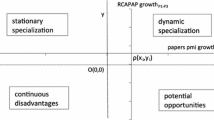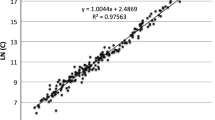Abstract
The relationship between the size of national scientific activities of advanced countries and the degree of specialization by fields of science is examined using bibliometric indicators of the number of papers and of paper citations. A negative relation between the amount of scientific activity and the degree of scientific specialization has emerged, with Japan and, to a lesser extent Italy, showing a specialization degree higher than expected. Countries with established scientific traditions (such as the US, the UK, the Netherlands, and Switzerland) have a lower than expected specialization degree, suggesting a more diversified range of research activities. Over time, however, most countries have reduced their scientific specialization, a pattern which is in contrast with recent research on patents and technological specialization.
Similar content being viewed by others
Notes and references
See, among others, the overviews offered by the reports of the US National Science Board,Science and Engineering Indicators, Washington D.C., 1987, and of the OECD,Science and Technology Outlook 1988, Paris, 1988.
D. Archibugi, M. Pianta, Specialization and size of technological activities in industrial countries: the analysis of patent data. In:M. Perlman (Ed.),Entrepreneurship., Technological Innovation and Economic Growth: International Perspectives, University of Michigan Press, Ann Arbor (forthcoming).
Among an extensive literature on the relationship between science and technology, seeN. Rosenberg, How exogenous is science? In:Inside the Black Box, Cambridge University Press, Cambridge, 1982;D. de Solla Price, The science/technology relationship, the craft of experimental science, and policy for the improvement of high technology innovations,Research Policy, 13, (1984);D. Archibugi, Paradigms and revolutions: from science to technology?, Paper presented at the EASST 4th annual meeting, Strasbourg, October 1986. An empirical study of this relationship is in:F. Narin, E. Noma, Is technology becoming science?,Scientometrics, 7 (1985) 369.
A recent survey of national cases can be found in:B. Martin, J. Irvine,Research Foresight. Priority-Setting in Science, Pinter, London, 1989.
The relative decline of British scientific output has been the subject of a long standing debate, which has raised questions also on the significance of the database used here. See,B. Martin, J. Irvine, F. Narin, C. Sterritt, The continuing decline of British science,Nature, 330 (12 November 1987) 123;L. Leydersdorff, Problems with the ‘measurement’ of national scientific performance,Science and Public Policy, 15 (1988) 149;T. Braun, W. Glänzel, A. Schubert, Assessing assessments of British science: some facts and figures to accept or decline,Scientometrics 15 (1989) 165;J. Irvine, B. Martin, International comparisons of scientific performances revisited,Scientometrics, 15 (1989) 369.
Here we use the total number of citations received by the papers over the period considered, and obviously older papers have a greater probability of being cited than recent ones. Summing together the citations received by papers of different years may combine data which are not entirely comparable, but for our descriptive purposes this variable offers a valuable overview of the relative position of different countries. A possible distortion, however, may be introduced in the average number of citations. For the countries where the average impact of their papers, measured by the number of citations received, has rapidly changed over time, this indicator may underestimate the change. However, we have found a generally stable pattern, and for our purposes an aggregate picture for an extended period of time is a fairly satisfactory indicator of the impact of a country's papers in the world scientific literature.
See note 2D. Archibugi, M. Pianta, Specialization and size of technological activities in industrial countries: the analysis of patent data. In:M. Perlman (Ed.),Entrepreneurship., Technological Innovation and Economic Growth: International Perspectives, University of Michigan Press, Ann Arbor (forthcoming).
The 96 subfields considered, listed in theAppendix, are basically those provided by the disaggregation of the CHI Research database; a few classes with the lowest number of papers have been combined together. These subfields provide a detailed picture of the distribution of a country's scientific activities within the areas of Clinical Medicine, Biomedical Research, Biology, Chemistry, Physics, Earth and Space Sciences, Engineering and Technology, Mathematics.
The chi square statistic is calculated as the sum of the squares of the differences between a country's share of its papers in a subfield and the share of the world total in that subfield. The index in equal to zero when the country's sectoral distribution is the same as the world's and no national specialization can be found. The higher the index, the greater the degree of national specialization in a few subfields of scientific activity. In our calculations, the percent values have been multiplied by 100.
See note 2D. Archibugi, M. Pianta, Specialization and size of technological activities in industrial countries: the analysis of patent data. In:M. Perlman (Ed.),Entrepreneurship., Technological Innovation and Economic Growth: International Perspectives, University of Michigan Press, Ann Arbor (forthcoming).
Also for patenting, the degree of specialization is based on the chi square value calculated on the percent distribution by subfields of a country's patents, compared to the world's distribution. The indicator for the size of a country's technological activities is cumulative R&D expenditure. For further details see the paper referred to in note 2.
A more detailed analysis of the patterns shown by science and technology can be found in:D. Archibugi, M. Pianta,The European Technological Specialization, EEC Final Report, December 1990.
Author information
Authors and Affiliations
Additional information
Rotating first authorship. This paper is part of a research on the Scientific and Technological Specialization of advanced countries jointly financed by the Commission of European Communities, D.G. XII, Science, Research and Development, Service Research Evaluation, and the Italian National Research Council. We are grateful to PatriziaPrincipessa and RobertoSimonetti for research assistance.
Rights and permissions
About this article
Cite this article
Pianta, M., Archibugi, D. Specialization and size of scientific activities: A bibliometric analysis of advanced countries. Scientometrics 22, 341–358 (1991). https://doi.org/10.1007/BF02019767
Received:
Issue Date:
DOI: https://doi.org/10.1007/BF02019767




